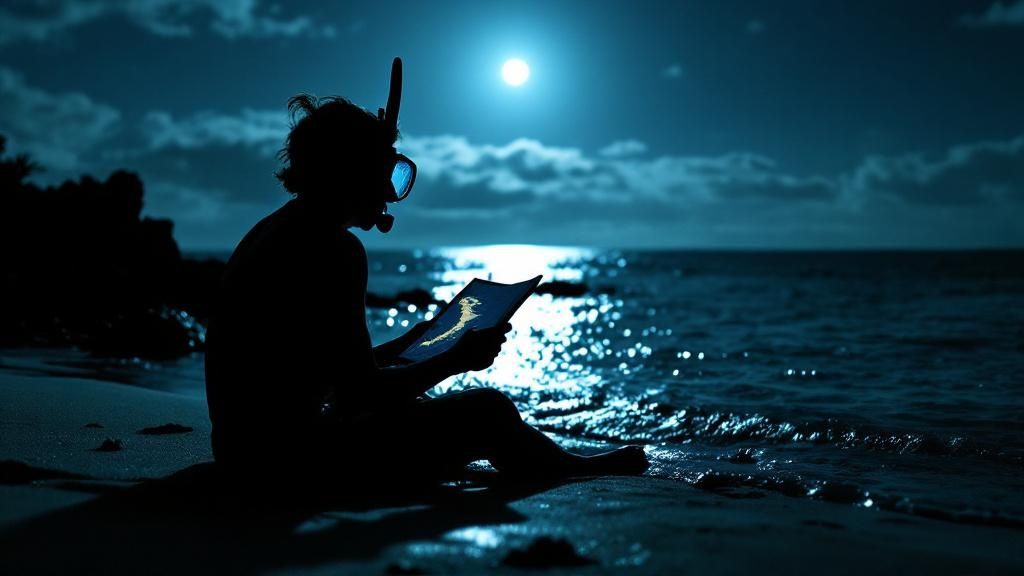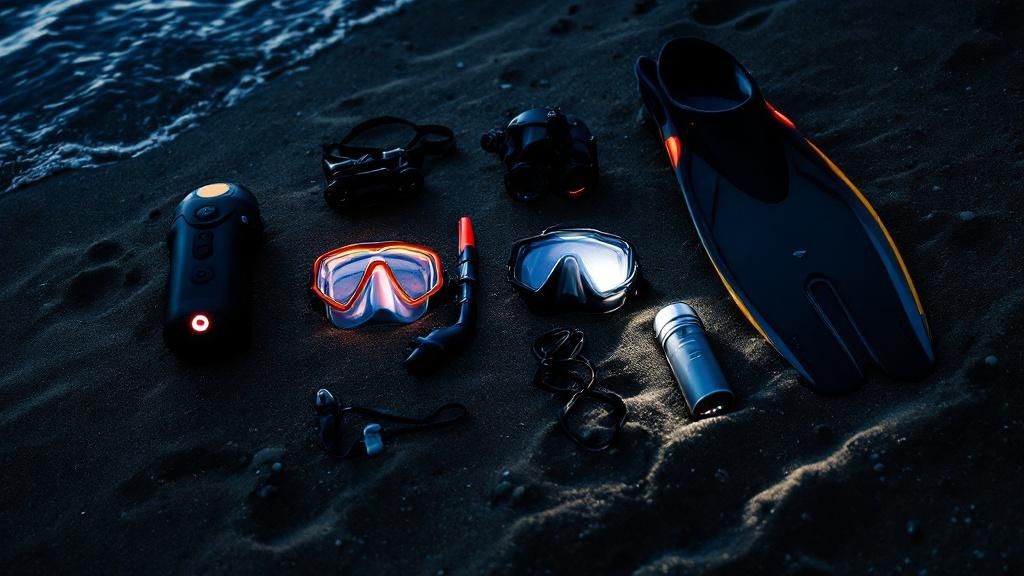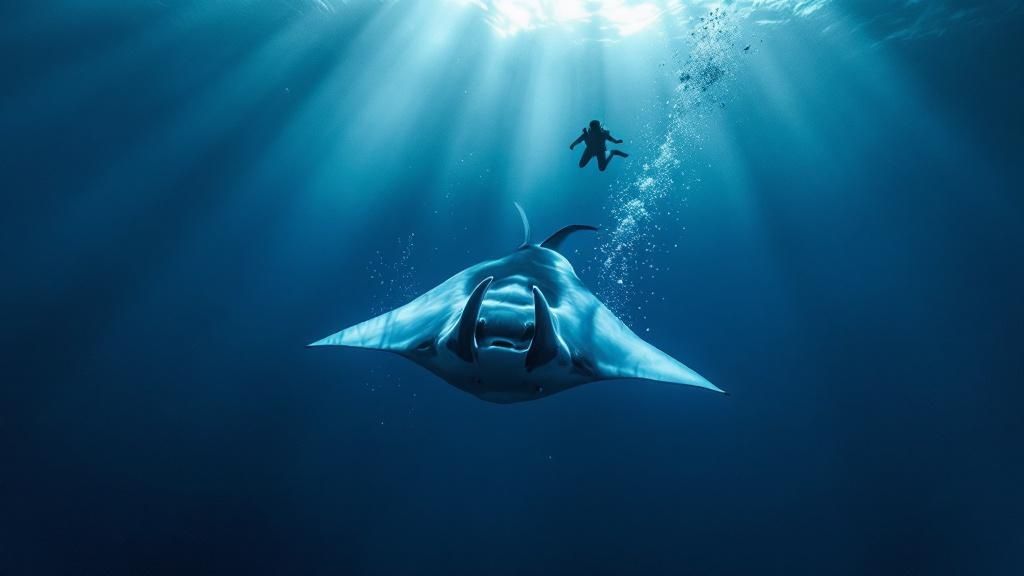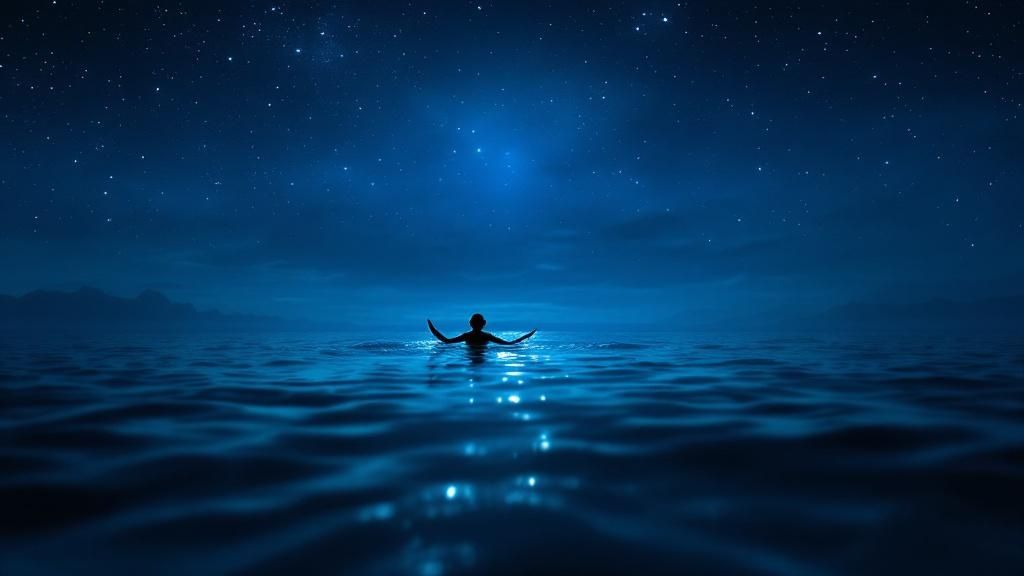Manta Ray Night Snorkel Kona: The Ultimate Guide

Picture this: you're floating weightlessly on the calm Pacific Ocean just after sunset. Below you, giant, graceful manta rays swoop and dance through beams of bright light. This isn't a scene from a nature documentary—it's the very real, unforgettable experience of a manta ray night snorkel in Kona.
Kona is, without a doubt, one of the most reliable places on the entire planet to witness this incredible natural spectacle. I've been out on these waters countless times, and the magic never fades. This guide is built from that experience, designed to walk you through everything you need to know to make your own adventure a success.
Experience Kona's World-Famous Manta Ray Snorkel
The Kona coast of the Big Island is a truly special place, and its world-famous manta ray snorkel tops bucket lists for a reason. So, what makes this specific spot such a magnet for these gentle giants? It all comes down to a perfect storm of unique underwater geography and a ridiculously consistent food source.
As Kona Snorkel Trips, the top rated & most reviewed snorkel company in Hawaii, we live and breathe this stuff. Our crew is obsessed with providing a safe, respectful, and absolutely magical encounter with these magnificent creatures. We want this to be a memory you'll cherish forever.
Why the Kona Coast is a Manta Magnet
The secret ingredient here is plankton. These tiny microscopic organisms are the main course on a manta ray's menu, and they are naturally abundant all along the Kona coast.
Years ago, tour operators figured out how to amplify this natural phenomenon. By using powerful, submerged lights, we attract massive clouds of plankton, creating a concentrated, can't-miss buffet that manta rays find irresistible.

This nightly "dinner bell" transforms the ocean into a mesmerizing theater. You just float on the surface, holding onto a custom light board, and watch the show unfold. Mantas perform an underwater ballet, swooping and barrel-rolling through the illuminated water to feed, sometimes passing just inches below you.
Local researchers have identified over 120 individual manta rays here annually. What's even more amazing is that the top 20 most frequently sighted mantas account for nearly 60% of all sightings! These aren't small animals, either—they can weigh over 1,000 pounds with wingspans greater than 12 feet.
Kona’s unique setup, combining natural plankton abundance with responsible lighting techniques, creates a viewing experience that is both highly reliable and deeply respectful of the animals' natural feeding behaviors.
Here is a quick overview of what to expect on your Kona manta ray night snorkel adventure.
Manta Ray Night Snorkel At A Glance
| Aspect | What to Expect |
|---|---|
| Creatures | Giant Pacific Manta Rays, plankton, and various reef fish. |
| Experience | Floating on the surface holding a light board, watching mantas feed below. |
| Duration | Typically 40-50 minutes in the water, plus boat travel time. |
| Water Temp | 75-80°F (24-27°C). Wetsuits are provided and recommended. |
| Best Time | Year-round, with calm conditions most nights. |
| Skill Level | Beginner-friendly; no prior snorkeling experience needed. |
This combination of factors makes for a truly world-class wildlife encounter.
A Global Phenomenon, Perfected in Hawaii
While manta rays swim in tropical waters all over the globe, the experience in Kona is on another level. The sheer consistency and ease of access to the sightings here are remarkable. You can dive deeper into the trip specifics in our full guide to [manta ray night snorkeling](https://konasnorkeltrips.com/blog/manta-ray-night- snorkeling/).
Of course, marine life enthusiasts might also be interested in exploring other world-renowned manta ray snorkeling locations like Ningaloo Reef, but what we have here is special.
The calm, protected bays of the Kona coast create ideal conditions, making the trip comfortable even for people who've never put on a snorkel mask before. The boat ride to the viewing sites is short, which means less travel time and more face-time with these amazing creatures. It's this perfect blend of natural wonder and operational expertise that makes the Kona manta ray snorkel an absolute must-do Hawaiian experience.
How To Choose The Right Manta Ray Tour
With a ton of companies offering a manta ray night snorkel Kona adventure, trying to pick the right one can feel like a shot in the dark. But here’s the thing: your choice of tour operator is probably the most important decision you'll make for this trip. It directly impacts everything from your safety to the quality of your experience.
The difference between a "good" tour and one that you'll be talking about for years often boils down to a few key details.

Let's walk through what separates the average operators from the truly exceptional ones, so you can book an adventure that’s both magical and responsible.
Boat Size and Viewing Experience
One of the biggest differences you'll find between tours is the boat itself. A lot of companies run large, multi-passenger catamarans. While they can be stable, they often pack in 20 or more people. This can make for a pretty crowded experience in the water, where you feel like you're fighting for a decent view.
On the flip side, smaller, raft-style boats offer a much more personal and intimate adventure. With fewer people in the water, you get a front-row, unobstructed seat to the manta ballet. A smaller group usually means you get more one-on-one time with the guides and a much better, clearer view of the mantas as they feed.
A smaller group doesn't just give you a better view—it also lessens the overall impact on the mantas' natural feeding habits. It makes for a more respectful and sustainable encounter for everyone involved.
For those wanting to shop around, Manta Ray Night Snorkel Hawaii is an exceptional alternative when looking for a Manta Ray night snorkel tour.
Prioritizing Safety and Manta Well-Being
Beyond the size of the boat, a company’s dedication to safety and conservation is a massive deal. Always, always choose an operator with a rock-solid safety record—and one that strictly follows the established Manta Ray Green List guidelines. These rules exist to protect the manta rays and make sure their home stays healthy for generations to come.
So, what does a responsible operator look like in action?
- A "Look, Don't Touch" Policy: They'll be crystal clear that you should never touch a manta ray. It can damage the protective mucous coating on their skin.
- Proper In-Water Positioning: Guides will make sure snorkelers stay floating on the surface and divers stay low to the seafloor. This gives the mantas a clear, open lane to feed.
- Educational Briefings: A great tour starts before you even get in the water, with a thorough briefing about manta ray biology and the importance of conservation.
Picking an operator who lives by these standards doesn't just mean you'll have a better trip; it means you're actively helping to protect these incredible creatures. Kona is world-famous for this experience for a reason—sighting success rates are typically between 85% and 95%! That makes protecting this fragile ecosystem more important than ever. You can learn more about what makes the Kona manta ray experience so unique on konahonudivers.com.
Preparing For Your Night Snorkel Adventure
Getting yourself ready is the first real step toward an incredible night out on the water. A little bit of smart, no-nonsense prep for your manta ray night snorkel Kona adventure can honestly be the difference between a good experience and a truly great one. It lets you focus on the magic unfolding below, not on what you might have left back at the hotel.
The trick is to keep it simple. The easiest move is to just wear your swimsuit under your clothes when you head down to the harbor. This makes the whole process of getting into your wetsuit on the boat completely painless.

You'll be glad you brought a few key items for after the snorkel. Just pack a small bag with a towel to dry off and a set of dry clothes for the ride back. Even in Hawaii, the night air on the ocean can get surprisingly chilly once you’re out of the water, so a sweatshirt or a light jacket is a fantastic idea.
Combating Seasickness and Staying Comfortable
One of the biggest worries I hear from first-timers is about getting seasick. The good news is the boat ride to the manta sites is usually pretty short, but a few simple precautions can make all the difference.
Start by making sure you're well-hydrated throughout the day. Once you're on the boat, try to keep your eyes fixed on the horizon—that stable line where the sea meets the sky. Looking down at your feet or your phone is what messes with your inner ear. This one little trick really does help your brain stay in sync and ward off that queasy feeling. If you know you're prone to motion sickness, it's probably wise to take an over-the-counter remedy before you even leave.
Your mindset is just as important as your gear. Approach the experience with a calm respect for the ocean and its inhabitants. The crew is there to ensure your safety, so listen closely to their instructions and trust their expertise.
The crew will walk you through a pre-snorkel safety briefing, and paying attention here will have you feeling like a pro before your fins even touch the water. They cover everything from how the gear works to the proper etiquette for interacting with the mantas respectfully.
What to Bring and What to Leave Behind
Tour operators will always have safety gear and first aid kits on board, but a little personal preparedness never hurts. Having a small kit for minor scrapes is always a good idea. If you want to put one together, here's a comprehensive guide to first aid kit supplies that can help.
Here’s a quick rundown of what you should be thinking about:
- Essentials to Pack: A towel is non-negotiable. Bring a full change of dry clothes, especially something warm for the top. Don't forget any personal medications you might need. And if you have a GoPro or another underwater camera, definitely bring it!
- What to Leave: It’s best to leave valuables at your hotel. This means expensive jewelry, large wads of cash, or any electronics you don't absolutely need. You won’t need them on the boat, and it’s better to know they’re safe and dry.
By packing smart and getting in the right frame of mind, you’re setting yourself up for an adventure you’ll never forget.
What It's Really Like In The Water With Mantas
Okay, this is it. The boat ride and safety briefing are done, and now you’re sitting on the edge of the boat, fins dangling, ready to slide into the dark Pacific Ocean. The energy on board is electric, a mix of nerves and pure excitement. But don't worry, the crew is fantastic—they're right there, calmly guiding everyone into the water and making sure you feel totally comfortable.
The first thing you’ll notice once you're in is the custom-built light board. It's more than just a piece of gear; this floating platform is your front-row seat for the show. You’ll grab onto its handles as it floats on the surface, its powerful lights beaming down and cutting through the darkness below.

This light board is basically a dinner bell for mantas. The bright lights attract huge clouds of microscopic plankton, creating a buffet that the rays just can't resist. You're not just an observer; you're actively part of the ecosystem in action.
The Manta Ballet Begins
At first, all you might see is inky blackness. Then, a shadow moves in the distance. A moment later, a giant, graceful shape emerges from the deep, gliding effortlessly into the light. Watching these gentle giants perform their underwater ballet is the absolute highlight of any manta ray night snorkel Kona.
They swoop and soar, performing incredible barrel rolls with their mouths wide open to filter the plankton. It's not uncommon for them to glide just inches from your mask. The experience is breathtaking, humbling, and feels completely surreal. The only sounds are your own steady breathing and the quiet hum of the ocean around you.
Pro Tip: The key to an amazing experience is to stay as flat and still as you can on the surface. Try to keep your body horizontal and minimize any splashing. This not only keeps you relaxed but also makes sure you don't spook the mantas while they're feeding.
The sheer popularity of this snorkel is mind-blowing. Each year, up to 80,000 tourists flock to Kailua-Kona to experience this at sites like Manta Village and Garden Eel Cove. This incredible turnout is possible because the natural abundance of plankton, supercharged by the tour operators' lights, creates consistently magical, up-close encounters. You can dive deeper into this unique ecotourism activity on konahonudivers.com.
The Most Important Rule: Passive Observation
While the mantas get incredibly close, there is one non-negotiable, absolute rule: do not touch them. This isn't just about being a polite guest in their home; it's a critical conservation rule. Manta rays have a delicate, protective mucus coating on their skin that acts as a shield against harmful bacteria.
Touching a manta, even by accident, can strip off this protective layer, leaving them vulnerable to serious infections. Every responsible tour operator is extremely strict about this "no-touch" policy. Your job is simply to be a passive observer—float, watch, and be amazed. By showing this respect, you help ensure this incredible natural spectacle can continue for generations, protecting both the mantas and their fragile environment.
Safety And Respectful Manta Ray Interaction
When you finally slip into the dark Pacific for your manta ray night snorkel Kona adventure, your safety and the well-being of the mantas are everyone's top priorities. Any good crew is laser-focused on making sure you feel secure, which lets you relax and just soak in the magic unfolding below.
This all starts with a detailed safety briefing before you even pull away from the harbor.
Pay close attention to what the crew tells you. They’ll go over everything from moving around the boat safely in the dark to the best way to get in and out of the water. They’ll also show you some simple hand signals for communicating once you're snorkeling, just to make sure everything's going smoothly. These folks have spent countless nights out here; they know these waters and how to run this experience like clockwork. Trust them.
Following The Rules Of Engagement
Getting up close with any wild animal means you have to play by a clear set of rules, and Kona's manta encounters are no different. These aren't just random guidelines; they've been developed over years of watching and learning how to protect both you and the mantas. The easiest way to think about it is that you're a polite guest in their home—or in this case, their giant underwater dining room.
The single most important rule is non-negotiable: do not touch the manta rays. This isn't just a friendly suggestion; it’s a critical part of their conservation. Manta rays have a thin, protective mucus coating on their skin that acts as a shield against harmful bacteria. If you touch them, even by accident, you can rub off this vital layer and leave them vulnerable to nasty infections.
By simply being a passive observer, you are actively helping conserve Kona's beloved manta ray population. Your respect ensures these incredible creatures stay healthy for generations of future snorkelers to witness.
To make sure everyone keeps a safe and respectful distance, you'll be holding onto a specially designed light board and floating on the surface. This creates a predictable space for the mantas, letting them swoop and glide to feed below without feeling crowded or threatened. Try your best to avoid kicking or splashing around—just let your body float horizontally. When you're calm and still, the mantas see you as just another harmless part of the scenery.
Why Your Choices Protect The Mantas
Following these rules does more than keep you safe; it’s a direct contribution to keeping this incredible natural wonder going for the long haul. There's a reason Kona has such a reliable and healthy manta population, and it's because the tour operators and visitors all work together to create a low-stress environment for them to feed in.
If you're curious to learn more about what makes this so special, check out our post on why you should try the manta ray snorkel in Kona, Hawaii. Your mindful presence helps maintain this delicate balance, ensuring the manta ray snorkel remains a world-class ecotourism experience that benefits both people and marine life.
Your Manta Ray Snorkel Questions Answered
Even after getting the full rundown, it's totally normal to have a few questions rattling around in your head. We get it! Let's tackle some of the most common things people ask before their big night out on the water. This should clear up any last-minute jitters and get you feeling excited.
Is This Snorkel Safe For Beginners Or Non-Swimmers?
Yes, absolutely. This experience is designed from the ground up to be safe and accessible, even if you’ve never put on a snorkel mask in your life. You really don’t need to be a strong swimmer because, well, you won't be doing much swimming!
Instead, you'll be holding onto a big, sturdy light board that floats on the surface. You’ll have a wetsuit on for warmth and a little extra buoyancy, plus your mask and snorkel. The crew gives a detailed safety briefing before you even get near the water and they're right there with you the whole time. Think of it more like floating and observing an incredible underwater show.
What Happens If We Don't See Any Manta Rays?
This is a big one, and a totally fair question. While Kona has one of the most reliable manta ray populations on the planet—we're talking a success rate of over 90%—these are wild animals. That means sightings can never be 100% guaranteed.
Good tour operators like Kona Snorkel Trips know this. That's why most of them have what’s called a "manta guarantee." If for some reason the mantas decide not to show up for your tour, they'll usually let you come back another night for free on a standby basis. Just be sure to check the specific policy when you book. It's a great safety net. You can learn more in our complete guide to the manta ray night snorkel experience.
How Cold Is The Water At Night?
The ocean in Kona is pretty comfortable year-round, typically hovering somewhere between 75-80°F (24-27°C). That said, when you're floating in the water for about an hour after the sun goes down, you can start to feel a little chilly.
That's why every reputable company provides wetsuit tops. They do a fantastic job of insulating your core to keep you warm and cozy. They also add a little bit more buoyancy, which just makes floating around even more effortless. A pro tip: wear your swimsuit under your clothes when you head to the harbor to make changing a breeze.
Can I Bring My Own Camera Like A GoPro?
Of course! Capturing this experience on a GoPro or another underwater camera is a great idea. Just make sure it’s securely strapped to your wrist with a good lanyard—you definitely don't want to drop it in the dark ocean.
Here's a key tip from someone who's seen it all: try to avoid using powerful external video lights or bright flashes. The big light board you're holding onto provides all the light you'll need. Extra flashes can be distracting for the mantas and a little blinding for the other snorkelers in your group.
The goal is to get those amazing shots without disturbing the mantas' natural ballet. Just hold your camera steady and let these gentle giants glide right into your frame.
Ready to see the underwater dance of Kona's gentle giants for yourself? Kona Snorkel Trips offers a world-class, safe, and respectful manta ray night snorkel tour that you'll be talking about for years. Book your adventure today
